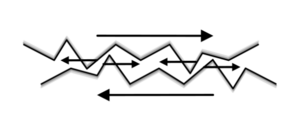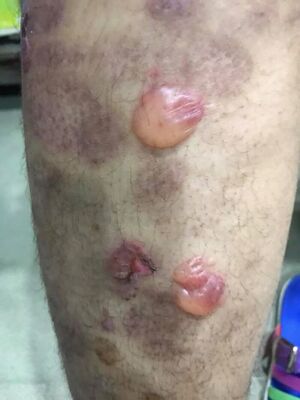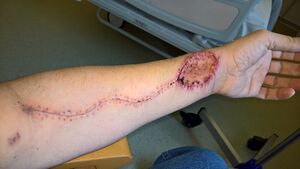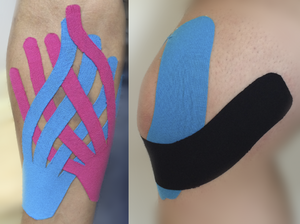Friction and its Application: Difference between revisions
(added images) |
No edit summary |
||
| Line 5: | Line 5: | ||
Friction plays a significant role in physiotherapy, especially in manual therapy techniques and therapeutic exercises. Friction, which is normally taken as a hindrance in everyday life, holds an important role in physiotherapy. It serves as a fundamental concept guiding movement mechanics, exercise selection, and injury prevention strategies. | Friction plays a significant role in physiotherapy, especially in manual therapy techniques and therapeutic exercises. Friction, which is normally taken as a hindrance in everyday life, holds an important role in physiotherapy. It serves as a fundamental concept guiding movement mechanics, exercise selection, and injury prevention strategies. | ||
'''What is Friction?''' | == '''What is Friction?''' == | ||
[[File:Friction surface microstructure.png|thumb|friction ]] | [[File:Friction surface microstructure.png|thumb|friction ]] | ||
Friction is the opposing force that occurs between surfaces in contact and parallel to each other. In | Friction is the opposing force that occurs between surfaces in contact and parallel to each other. In our body, it manifests in various scenarios, such as the interaction between joint surfaces, the contact between skin and supportive equipment, or the interface between the body and external surfaces during movement.<ref name=":1">Federal University of Technology, Owerri, & Tropical Publishers Nigeria. (2016). Human biomechanics: Basic and applied. Federal University of Technology, Owerri and Tropical Publishers Nigeria.https://www.researchgate.net/publication/357152541_Human_Biomechanics_Basic_and_Applied</ref> | ||
== Laws Governing Friction == | === Laws Governing Friction === | ||
The laws governing friction are <ref name=":1" />: | |||
1. | 1. Type of the Surface: Friction depends on the nature of the surfaces in contact, whether rough or smooth. | ||
2. Opposition to Motion: | 2. Opposition to Motion: Frictional force acts to oppose the motion, serving as a stabilizing force during movement. | ||
3. | 3. Relative Velocity: The frictional force varies with the relative velocity between surfaces. | ||
4. | 4. Surface Area: Friction is independent of the surface area of contact between the surfaces | ||
5. | 5. Reaction Force: The frictional force is proportional to the reaction force pressing the surfaces together. | ||
== Applications of Friction in Physiotherapy == | == Applications of Friction in Physiotherapy == | ||
| Line 64: | Line 64: | ||
6. [[Taping]] Techniques: such as kinesiology tape. we may apply friction to the adhesive side of the tape to activate its heat-sensitive properties, enhancing its adhesion to the skin and improving its therapeutic effects, such as providing support, reducing swelling, and enhancing proprioception.<ref>Mohamadi M, Piroozi S, Rashidi I, Hosseinifard S. Friction massage versus kinesiotaping for short-term management of latent trigger points in the upper trapezius: a randomized controlled trial. Chiropr Man Therap. 2017;25:25.https://link.springer.com/article/10.1186/s12998-017-0156-9</ref> | 6. [[Taping]] Techniques: such as kinesiology tape. we may apply friction to the adhesive side of the tape to activate its heat-sensitive properties, enhancing its adhesion to the skin and improving its therapeutic effects, such as providing support, reducing swelling, and enhancing proprioception.<ref>Mohamadi M, Piroozi S, Rashidi I, Hosseinifard S. Friction massage versus kinesiotaping for short-term management of latent trigger points in the upper trapezius: a randomized controlled trial. Chiropr Man Therap. 2017;25:25.https://link.springer.com/article/10.1186/s12998-017-0156-9</ref> | ||
== Physiological effects of friction == | === Physiological effects of friction massage === | ||
* Increased vasodilation<ref>Cambron JA, Dexheimer J, Coe P. Changes in blood pressure after various forms of therapeutic massage: A preliminary study. J Altern Complement Med. 2006;12:65–70.</ref><ref>Holey E, Cook E. Evidence-Based Therapeutic Massage. A Practical Guide for Therapists. 2nd ed.Edinburgh: Churchill Livingstone; 2003</ref>-Vasodilation refers to the expansion of blood vessels. Friction applied to the skin raises the temperature in localized areas, prompting blood vessels to unwind and expand. This expanded vasodilation facilitates greater delivery of oxygen and nutrient-rich blood to the muscles. | * Increased vasodilation<ref>Cambron JA, Dexheimer J, Coe P. Changes in blood pressure after various forms of therapeutic massage: A preliminary study. J Altern Complement Med. 2006;12:65–70.</ref><ref>Holey E, Cook E. Evidence-Based Therapeutic Massage. A Practical Guide for Therapists. 2nd ed.Edinburgh: Churchill Livingstone; 2003</ref>-Vasodilation refers to the expansion of blood vessels. Friction applied to the skin raises the temperature in localized areas, prompting blood vessels to unwind and expand. This expanded vasodilation facilitates greater delivery of oxygen and nutrient-rich blood to the muscles. | ||
| Line 75: | Line 74: | ||
== Conclusion == | == Conclusion == | ||
Understanding the laws governing friction is essential for rehabilitation professionals to analyze movement patterns and design effective rehabilitation programs. | |||
In summary, friction in physiotherapy offers diverse therapeutic benefits, including improved blood circulation, breakdown of scar tissue, enhanced tissue elasticity, and increased range of motion. By incorporating friction techniques into treatment protocols, physiotherapists can effectively address various musculoskeletal conditions and optimize patient outcomes. | In summary, friction in physiotherapy offers diverse therapeutic benefits, including improved blood circulation, breakdown of scar tissue, enhanced tissue elasticity, and increased range of motion. By incorporating friction techniques into treatment protocols, physiotherapists can effectively address various musculoskeletal conditions and optimize patient outcomes. | ||
Revision as of 09:25, 23 April 2024
Introduction[edit | edit source]
Friction plays a significant role in physiotherapy, especially in manual therapy techniques and therapeutic exercises. Friction, which is normally taken as a hindrance in everyday life, holds an important role in physiotherapy. It serves as a fundamental concept guiding movement mechanics, exercise selection, and injury prevention strategies.
What is Friction?[edit | edit source]
Friction is the opposing force that occurs between surfaces in contact and parallel to each other. In our body, it manifests in various scenarios, such as the interaction between joint surfaces, the contact between skin and supportive equipment, or the interface between the body and external surfaces during movement.[1]
Laws Governing Friction[edit | edit source]
The laws governing friction are [1]:
1. Type of the Surface: Friction depends on the nature of the surfaces in contact, whether rough or smooth.
2. Opposition to Motion: Frictional force acts to oppose the motion, serving as a stabilizing force during movement.
3. Relative Velocity: The frictional force varies with the relative velocity between surfaces.
4. Surface Area: Friction is independent of the surface area of contact between the surfaces
5. Reaction Force: The frictional force is proportional to the reaction force pressing the surfaces together.
Applications of Friction in Physiotherapy[edit | edit source]
Frictional effects play a crucial role in various aspects of physiotherapy practice:[1]
1. Supportive Equipment: The selection of supportive equipment, such as crutches or walking aids with rubber tips, relies on the high coefficient of friction provided by rubber against ground surfaces.
'2. Skin Protection: Friction management is essential to prevent skin injuries, such as blistering, which may occur in areas of high friction during movement or prolonged pressure.
3. Joint Functionality: Understanding the role of synovial fluid and joint mechanics helps in maintaining joint health and function, as synovial fluid serves as a lubricant to reduce friction between joint surfaces.
4. Exercise Design:Physiotherapists consider friction when designing exercises to enhance movement efficiency, reduce joint stress, and improve functional outcomes.
Effects of Friction in Physiotherapy[edit | edit source]
While friction is essential for movement and stability, its excessive or inefficient application can lead to adverse effects[1]:
1. Tissue Damage: Prolonged or excessive friction can cause the wearing and tearing of tissues, leading to pain, inflammation, and reduced mobility.
2. Energy Consumption: Friction contributes to the use of energy during movement, leading to increased fatigue and potential overheating of tissues.
3. Reduced Efficiency: Inefficient frictional interactions can impair movement efficiency, limiting the effectiveness of rehabilitation interventions.
Types of Friction Techniques Used in Physiotherapy[edit | edit source]
1.Soft Tissue Mobilization: We physiotherapists often use friction massage techniques to mobilize soft structures such as
- muscles,
- tendons,
- ligaments,
- fascia.
Friction massage involves applying pressure and rubbing movements directly to the affected area, aiming to break down adhesions, scar tissue, and muscle knots to improve tissue flexibility, reduce pain, and enhance circulation to promote healing.[2]
2. Cross-Fiber Friction Massage: in this technique friction is applied perpendicular to the direction of muscle fibers. It is commonly used to target specific areas of tissue dysfunction or to break down adhesions between muscle layers. Cross-fiber friction massage can help improve tissue mobility, reduce muscle stiffness, and alleviate pain.[3]
3. Scar Tissue Management: After surgery or injury, scar tissue may form, limiting the range of motion and causing pain and dysfunction. we use friction techniques, such as scar massage, to break down scar tissue adhesions and promote tissue remodeling. By applying controlled friction to the scar tissue, we can help improve tissue mobility, reduce scar adhesions, and enhance overall function.[4]
4. Trigger Point Release: Friction can be applied to trigger points—hyperirritable spots within taut bands of skeletal muscle—to release muscle tension and alleviate pain. we may use their fingers, thumbs, or specialized tools to apply localized friction to trigger points, helping to deactivate them and restore muscle function.
5. Joint Mobilization: we use friction during joint mobilization techniques to improve joint mobility and reduce stiffness. we may apply controlled friction to the joint surfaces to break down adhesions, increase synovial fluid circulation, and promote joint lubrication. This can help restore normal joint mechanics and reduce pain and dysfunction.[5]
6. Taping Techniques: such as kinesiology tape. we may apply friction to the adhesive side of the tape to activate its heat-sensitive properties, enhancing its adhesion to the skin and improving its therapeutic effects, such as providing support, reducing swelling, and enhancing proprioception.[6]
Physiological effects of friction massage[edit | edit source]
- Increased vasodilation[7][8]-Vasodilation refers to the expansion of blood vessels. Friction applied to the skin raises the temperature in localized areas, prompting blood vessels to unwind and expand. This expanded vasodilation facilitates greater delivery of oxygen and nutrient-rich blood to the muscles.
- Improved recovery[9]
- Breakdown / realignment of collagen fibres[4] and scar tissue -Frictions play a role in breaking down and realigning collagen fibers, which are a type of connective tissue characterized by their tough texture and high strength. Scar tissue, predominantly composed of collagen fibers, can develop following injury. However, it may disrupt the normal alignment of muscle fibers, leading to restrictions in movement and subsequent pain. Frictions, a specialized massage technique, target these restrictive tissues, aiming to realign the fibers to their natural orientation.
- Increased range of movement[10] and elasticity-Frictions additionally enhance tissue elasticity. When performed along the direction of muscle fibers, frictions can stretch and lengthen the tissues. Moreover, frictions elevate the temperature, promoting greater mobility of the tissue fibers, and facilitating their manipulation and stretching. Augmenting elasticity is crucial for improving mobility and preventing tightness
Conclusion[edit | edit source]
Understanding the laws governing friction is essential for rehabilitation professionals to analyze movement patterns and design effective rehabilitation programs.
In summary, friction in physiotherapy offers diverse therapeutic benefits, including improved blood circulation, breakdown of scar tissue, enhanced tissue elasticity, and increased range of motion. By incorporating friction techniques into treatment protocols, physiotherapists can effectively address various musculoskeletal conditions and optimize patient outcomes.
Reference[edit | edit source]
- ↑ 1.0 1.1 1.2 1.3 Federal University of Technology, Owerri, & Tropical Publishers Nigeria. (2016). Human biomechanics: Basic and applied. Federal University of Technology, Owerri and Tropical Publishers Nigeria.https://www.researchgate.net/publication/357152541_Human_Biomechanics_Basic_and_Applied
- ↑ Chaves P, Simões D, Paço M, Pinho F, Duarte JA, Ribeiro F. Cyriax's deep friction massage application parameters: Evidence from a cross-sectional study with physiotherapists.Musculoskeletal Science and Practice. 2017 Dec 1;32:92-7.
- ↑ Rasool F, Memon AR, Kiyani MM, Sajjad AG. The effect of deep cross friction massage on spasticity of children with cerebral palsy: A double-blind randomised controlled trial. J Pak Med Assoc. 2017;67:87.https://www.researchgate.net/profile/Aamir-Memon-3/publication/311775535_The_effect_of_deep_cross_friction_massage_on_spasticity_of_children_with_cerebral_palsy_A_double-blind_randomised_controlled_trial/links/585a6b6308aeabd9a58ca55e/The-effect-of-deep-cross-friction-massage-on-spasticity-of-children-with-cerebral-palsy-A-double-blind-randomised-controlled-trial.pdf
- ↑ 4.0 4.1 Barnes SP, Ma Y, Patel B, Muthayya P. Efficacy of massage techniques for hypertrophic burn scars – A systematic review of the literature. J Burn Care Res. 2024;45(2):356-365. doi:10.1093/jbcr/irad140 https://academic.oup.com/jbcr/article-abstract/45/2/356/7270579
- ↑ Nor Azlin MN, Su Lyn K. Effects of passive joint mobilization on patients with knee osteoarthritis. Sains Malaysiana. 2011;40(12):1461-1465.http://www.ukm.edu.my/jsm/pdf_files/SM-PDF-40-12-2011/17%20Nor%20Azlin.pdf
- ↑ Mohamadi M, Piroozi S, Rashidi I, Hosseinifard S. Friction massage versus kinesiotaping for short-term management of latent trigger points in the upper trapezius: a randomized controlled trial. Chiropr Man Therap. 2017;25:25.https://link.springer.com/article/10.1186/s12998-017-0156-9
- ↑ Cambron JA, Dexheimer J, Coe P. Changes in blood pressure after various forms of therapeutic massage: A preliminary study. J Altern Complement Med. 2006;12:65–70.
- ↑ Holey E, Cook E. Evidence-Based Therapeutic Massage. A Practical Guide for Therapists. 2nd ed.Edinburgh: Churchill Livingstone; 2003
- ↑ Leivadi S, Hernandez-Reif M, Field T, et al. Massage therapy and relaxation effects on university dance students. J Dance Med Sci. 1999;3:108–112
- ↑ Hopper D, Deacon S, Das S, et al. Dynamic soft tissue mobilization increases hamstring flexibility in healthy male subjects. Br J Sports Med. 2004;39:594–598











